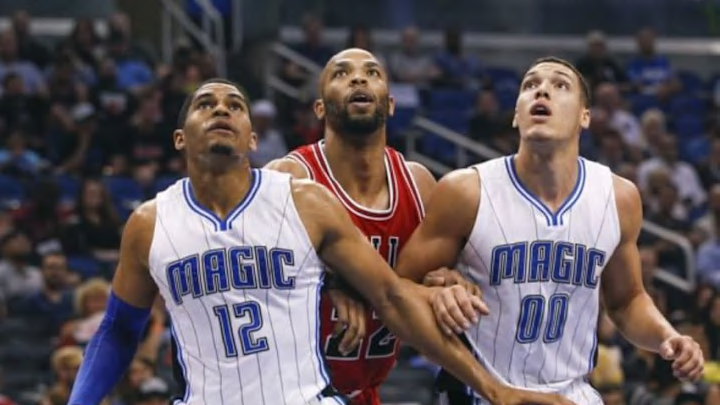The Orlando Magic started the year going small, joining scores of teams around the league doing just that. Size is proving not to be everything yet again.
In order to win big in today’s NBA, you have to be willing to play small.
Just look at the Golden State Warriors. The Warriors use an undersized lineup to great effect en route to a championship last season.
Now everyone wants a piece of the action, including the Orlando Magic.
By drafting players like Aaron Gordon and Mario Hezonja, acquiring Channing Frye and committing to Tobias Harris long term, Rob Hennigan has constructed a roster ready to embrace the small-ball revolution head on. And, as archetypal bigs who operate solely in and around the restricted area become an increasingly outdated commodity, that is no bad thing.
Talented as he may be, for every Andre Drummond there is a glut of power forwards capable of playing at the center position in smaller lineups. And just like Tim Duncan or Chris Bosh, Nikola Vucevic has proved himself perfectly capable of doing just that.
Vucevic is as comfortable operating within 10-15 feet of the basket as he is with his back to it, as his perfectly timed mid-range fadeaway game-winner against the Lakers recently proved.

It is perhaps no coincidence Vucevic was one of the first acquisitions of the Hennigan-era, his versatility making him the perfect centerpiece around which to build a team capable of playing small when necessary.
Although showing signs of improvement on the defensive end, offense is still very much Vucevic’s point of emphasis.
This year, in 14 games, he is averaging 15.1 points and 8.4 rebounds per game. Those numbers are down from last year’s 19.3 points and 10.9 rebounds per game, but that is largely due to a knee injury and a rotation that is forever changing.
Still, Vucevic’s contribution on the boards has been invaluable these past few years. Last year for example Vucevic had an 18.1 percent total rebound rate.
That is not quite as high as league-leading Andre Drummond’s 25.6 percent, but enough for Scott Skiles to feel confident enough to play without a traditional power forward on the court.
And for the most part that is exactly what he has done, using a combination of Tobias Harris and Channing Frye to fill that spot. As both players can rebound and both players can shoot, the approach has hardly hurt the team.
Harris has been especially effective on the boards, averaging 7.8 rebounds per game while also contributing 14.9 points per game. Orlando gets rebounds from other players too, with Victor Oladipo, Aaron Gordon and Elfrid Payton all making significant contributions.
Despite outrebounding the Boston Celtics 54-34 in Sunday’s game, there is still room for improvement on the glass. But as the success of the Magic’s defensive approach relies heavily on their ability to cut off the ball handler, collapse the paint and close out on shooters, it seems worth sacrificing some size for, say, the long-range shooting touch of Channing Frye.
Orlando is currently shooting the three pretty well – something, as John Denton of OrlandoMagic.com points out, Scott Skiles is actively encouraging:
"“One of our goals was to take more threes. We felt like if the team could shoot a similar percentage that the team shot last year and shoot more (threes) that that would be a good formula for us.”"
In fact, the Magic may have to shoot it a lot better than that, as an above-average 3-point percentage is key to any small lineup.
That said, having shooters like Frye, Harris and Evan Fournier on the floor really helps.
Frye is a flat-out 3-point threat who is currently shooting 46 percent from deep, while Harris and Fournier are equally adept whether shooting or driving to the hoop. Having the three of them on the perimeter these past four games has aided Payton’s performances, as he has logged a total of 31 assists since Victor Oladipo was moved to the bench.
Interestingly enough though, the true key to the success of a smaller line-up is a player who is yet to make a start this season: Aaron Gordon.
Gordon proved this summer he is still the most exciting prospect on Orlando’s roster by unveiling a rebuilt jump shot, an improved handle and the ability to knock down the three.
More importantly though, he is exceptionally versatile and his ability to guard multiple positions means he can play anywhere on the floor.
In the video linked above from a game last year against the Hawks, Gordon starts off guarding Thabo Sefolosha, before moving on to Pero Antic, before eventually knocking the ball away from Dennis Schroder.
A more recent example of his versatility came against the Sacramento Kings early this season, as he spent large periods of the second half guarding DeMarcus Cousins to great effect.
Gordon could be the Magic’s Swiss Army Knife, impacting the game on both ends of the floor while making a smaller line-up that features, say, him, Payton, Oladipo, Fournier and Tobias Harris a viable option.
That is not to say Orlando should necessarily commit to a smaller lineup for the sake of it, but rather use it as and when circumstances dictate.
Versatility is vital to its success and having a number of players who can play multiple positions on the roster gives the Magic the option to go small when necessary.
While getting more penetration from primary ballhandler Elfrid Payton, better pace from the offense and more trips to the line collectively will undoubtedly further the success of this approach long term, it is good to see Orlando embracing this modern way of playing the game.
Next: Andrew Nicholson cements himself in the rotation
Even if, for now at least, it remains a work in progress.
